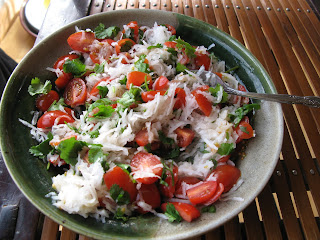Choti Idli
Mummy was always adding new pans, pots and cooking gadgets to her kitchen collection. Sometimes she discovered a new recipe needing that special gadget and other times she simply found a better, newer version of a gadget she alredy possesed. Whatever was the reason for her new purchase, we always benefited from it. She either bought the new gadgets for us or passed on the older version. Idli stand to make choti (small) idlies was one such purchase she made while visiting my brother in Surat. She bought several of these stands, keeping one for herself and giving others to my sister, sister in law and me. Idli, sambhar and chutney were standard fare for the parties at home. Idlies were considered light yet falvorful and festive, a departure from usual fried stuff like poories, bhatura served at parties. Making idlies was a ritual requiring lot of planning and multiple steps stating from soaking the dal, rice and then grinding and waiting for the batter to ferment. Recreating same taste




